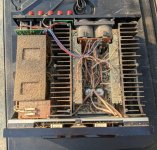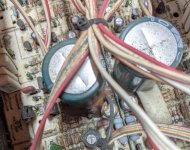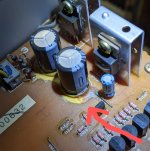Hi all, I just picked up an abused Yamaha M-85. Here's a photo of the inside. I have since vacuumed and blow out the inside as best that I can but the main board, in particular, is still grungy.
My first thought is to spray it with isopropyl alcohol, maybe try to get a small brush in there for a light scrub, and then flush out as much of the filth as I can with more alcohol.
Is this the best way to go about it? I don't want to do any more damage than has already been done by the glue that was used to hold the larger caps down.
Thanks for your thoughts.
My first thought is to spray it with isopropyl alcohol, maybe try to get a small brush in there for a light scrub, and then flush out as much of the filth as I can with more alcohol.
Is this the best way to go about it? I don't want to do any more damage than has already been done by the glue that was used to hold the larger caps down.
Thanks for your thoughts.
Attachments
I've hosed such things down with a garden hose - with the caveat that it's a scorching hot summers day, where it can sit in the hot, hot sun to cook off any remaining moisture quickly.
Still surprises me that it works w/o damage to anything, as long as it's hot enough to dry out fast (completely dry same day) Of course, never energize anything until you're sure it's completely dry. Maybe an additional week indoors, if you're not in a hurry. Power up slowly with variac.
Summer is cleaning season, because stuff can dry out fast in the hot sun -
Still surprises me that it works w/o damage to anything, as long as it's hot enough to dry out fast (completely dry same day) Of course, never energize anything until you're sure it's completely dry. Maybe an additional week indoors, if you're not in a hurry. Power up slowly with variac.
Summer is cleaning season, because stuff can dry out fast in the hot sun -
safely cleaning electronics
I use a lot of Simple Green [50/50 mix] and *recommend* something wooden... that will not harm the component being cleaned.
I use the Bamboo Skewers (for BBQ and grilling) that are stiff and "can dig into grunge" (solder flux, with solvents) with doing visible damage.
The tips can be wrapped in cotton. A stiff, "animal hair" brush is useful for scrubbing larger areas.
I would not use .any. metal tools which could actually do irreparable damage, to boards and components.
I use a lot of Simple Green [50/50 mix] and *recommend* something wooden... that will not harm the component being cleaned.
I use the Bamboo Skewers (for BBQ and grilling) that are stiff and "can dig into grunge" (solder flux, with solvents) with doing visible damage.
The tips can be wrapped in cotton. A stiff, "animal hair" brush is useful for scrubbing larger areas.
I would not use .any. metal tools which could actually do irreparable damage, to boards and components.
Simple green and a garden hose...
In spite it sounding radical, if not nuts... this approach.
At the advice of an experienced friend, I have done this with *simple vacuum tube gear.
And let it bake dry in the sun for a safe period. Waiting a week or so to apply any power.
*no switches, pots or wiring harnesses to foul.
I've hosed such things down with a garden hose - with the caveat that it's a scorching hot summers day, where it can sit in the hot, hot sun to cook off any remaining moisture quickly.
Summer is cleaning season, because stuff can dry out fast in the hot sun -
In spite it sounding radical, if not nuts... this approach.
At the advice of an experienced friend, I have done this with *simple vacuum tube gear.
And let it bake dry in the sun for a safe period. Waiting a week or so to apply any power.
*no switches, pots or wiring harnesses to foul.
Risky "West Virginia" method, has often worked for me...
I'm pleased to see that I'm not the only lunatic who takes a hose to a dust-choked piece of gear. Allow me to pontificate on my experiences
Obviously don't do this if it's a high value item and/or you have more practical methods. Do at your own risk.
The risk of water in electronics is understandable. Energized equipment getting soaked or submerged will likely damage the equipment and/or create a shock hazard. But how about un-energized equipment? In fact, gear that has been through a flood but was not energized, and is cleaned before re-use, has a good chance of being all right. This is even true of muddy or salt water. The key is "if it is well cleaned before re-use." This gave me an idea...
I have successfully cleaned various electronic items with ordinary tap water and dish detergents. This has the benefit of removing gunk that nothing else, including vacuuming seems to get. I usually spray it off well with a kitchen sprayer or hose. Soak in warmest/hottest water with soap/detergent available. Soak and rinse until clean.
Obviously the tough part is to make sure it's completely dried. Air drying and drip drying helps but far from certain. Certainly, drying in the hot sun is a good choice if you live in the desert Southwest where the relative humidity struggles to reach double digits. For the less fortunate such as me (Florida), more active measures are called for. The ideal method would be to vacuum or freeze dry if you had access to a special facility. If sending your component as a payload on a SpaceX flight is beyond your budget, an almost as good method is to use the kitchen oven. Again, big asterisk there. In my case, I can set the temp as low as about 170 degrees (F). This has not seemed to damage any components, beyond wrinkling plastic decals. I can't give you a time requirement; I'd guess 30-60 minutes minimum.
For the less fortunate such as me (Florida), more active measures are called for. The ideal method would be to vacuum or freeze dry if you had access to a special facility. If sending your component as a payload on a SpaceX flight is beyond your budget, an almost as good method is to use the kitchen oven. Again, big asterisk there. In my case, I can set the temp as low as about 170 degrees (F). This has not seemed to damage any components, beyond wrinkling plastic decals. I can't give you a time requirement; I'd guess 30-60 minutes minimum.
When everything seems dry, I let it cool and then De-oxit anything electrical. You might do well to lube other non-electrical moving parts.
I realize there's many downsides to this method: some components like a motor or a transformer may not be happy with residual water. I can attest that PC hard drives don't like being drowned My three Behringer INuke amps have been through the bath at least two or three times apiece, with no apparent malfunction, save the wrinkled decal issue mentioned above.
My three Behringer INuke amps have been through the bath at least two or three times apiece, with no apparent malfunction, save the wrinkled decal issue mentioned above.
I'm pleased to see that I'm not the only lunatic who takes a hose to a dust-choked piece of gear. Allow me to pontificate on my experiences
Obviously don't do this if it's a high value item and/or you have more practical methods. Do at your own risk.
The risk of water in electronics is understandable. Energized equipment getting soaked or submerged will likely damage the equipment and/or create a shock hazard. But how about un-energized equipment? In fact, gear that has been through a flood but was not energized, and is cleaned before re-use, has a good chance of being all right. This is even true of muddy or salt water. The key is "if it is well cleaned before re-use." This gave me an idea...
I have successfully cleaned various electronic items with ordinary tap water and dish detergents. This has the benefit of removing gunk that nothing else, including vacuuming seems to get. I usually spray it off well with a kitchen sprayer or hose. Soak in warmest/hottest water with soap/detergent available. Soak and rinse until clean.
Obviously the tough part is to make sure it's completely dried. Air drying and drip drying helps but far from certain. Certainly, drying in the hot sun is a good choice if you live in the desert Southwest where the relative humidity struggles to reach double digits.
When everything seems dry, I let it cool and then De-oxit anything electrical. You might do well to lube other non-electrical moving parts.
I realize there's many downsides to this method: some components like a motor or a transformer may not be happy with residual water. I can attest that PC hard drives don't like being drowned
Last edited:
I have cleaned last Year my vintage Pioneer amp and used IPA and a brush.
I've put the board vertically (pots and switches facing up) and let the fluid down while gently brushing the dirt down on a towel.
I've noticed that on some power resistors or "fusistors" the color bands were washed out. (Those usually marked with a triangle on the schematics).
They were fine but I've replaced them.
Pots and switches were lubricated again after re-assembling.
Be careful with sensitive things like analog VU's, Relays, tuning capacitors and the likes.
I did also clean and sprayed the chassis with zinc paint and sprayed the covers with new paint.
The tape deck had some corrosion on the back side and was sanded and painted in black but I've lost the lettering, but there are only 4 RCAs a DIN jack and a power inlet.
Serial number is still there on a plate riveted...
Remove that cracked brown glue under the main capacitors. Some folks say it becomes conductive.
I've put the board vertically (pots and switches facing up) and let the fluid down while gently brushing the dirt down on a towel.
I've noticed that on some power resistors or "fusistors" the color bands were washed out. (Those usually marked with a triangle on the schematics).
They were fine but I've replaced them.
Pots and switches were lubricated again after re-assembling.
Be careful with sensitive things like analog VU's, Relays, tuning capacitors and the likes.
I did also clean and sprayed the chassis with zinc paint and sprayed the covers with new paint.
The tape deck had some corrosion on the back side and was sanded and painted in black but I've lost the lettering, but there are only 4 RCAs a DIN jack and a power inlet.
Serial number is still there on a plate riveted...
Remove that cracked brown glue under the main capacitors. Some folks say it becomes conductive.
Last edited:
I confess having this done often in a similar way with amps, tape recorders and other stuff that had been rotting in discos, pubs etc. Putting the dirty thingy under the shower, regulating to max hot water temperature and then rinse, rinse, rinse. After a time all parts are clean as new, also hot and dry up quickly. Be careful with transformers as water inside them may dry out very, very slowly! After that cure I waited two days for drying. Putting it into the baking oven at 70C may work as well.I've hosed such things down with a garden hose - with the caveat that it's a scorching hot summers day, where it can sit in the hot, hot sun to cook off any remaining moisture quickly.
Still surprises me that it works w/o damage to anything, as long as it's hot enough to dry out fast (completely dry same day) Of course, never energize anything until you're sure it's completely dry. Maybe an additional week indoors, if you're not in a hurry. Power up slowly with variac.
Summer is cleaning season, because stuff can dry out fast in the hot sun -
Last edited:
I have used hot shower and dish-washing soap in a spray bottle and dish-washing- or tooth brush for such stuff, after wash shake off thoroughly excess water, and after that place a portable car heater fan at 1kW at approx 1m distance and let it dry up thoroughly for an hour or so, the crucial things is to dry up all the conductive stuff as fast a possible before the galvanic magic starts doing bad stuff.
Most commercial soaps and detergents are full of salt (its a thickener) and inappropriate for electronic cleaning as salt residue may cause corrosion over time. If you have to use them, rinse well in de-ionized water afterwards and dry thoroughly. A specialized pcb cleaning solution will avoid this pitfall.
the crucial things is to dry up all the conductive stuff as fast a possible before the galvanic magic starts doing bad stuff.
Yep. I've even been impatient with vacuum cleaners I've wholly dunked in water / soap cleaning solution, running them on 25V AC or so just to get things turning.
The small additional air flow through the canister plus the hot sun dries them out on the inside well enough to apply full line voltage the same day - successfully.
- Status
- This old topic is closed. If you want to reopen this topic, contact a moderator using the "Report Post" button.
- Home
- Amplifiers
- Solid State
- Cleaning an Extremely Dirty Amp


